
A Place for All Types of Learners
Mary Anne Sutherland, November 5, 2013

As an ISFP student, I kept thinking that confinement in school must be a mistake and that in a civilized society adults were not allowed to incarcerate children; but the nightmare did not end. To this day, adults continue to direct the young, ranging in ages from 5 to 18, on any number of things: where they should sit and for how long, what page they should be reading, writing, or memorizing, as well as what particular time of day those activities should take place. Young people are still told when to respond (with enthusiasm or not) and when to keep those answers to themselves, even when they are allowed to take a bathroom break. I always joke with my students that I spent my entire life in educational institutions out of spite. Maybe it wasn’t a joke.
As a first-year teacher, I again found it mind-boggling to imagine that my brilliant colleagues most often chose (of their own free will) to teach in very traditional classrooms. I was amazed that anyone would actually expect young people to respond positively while sitting in rows. The only thing I thought they might learn was to hate learning. I was astounded, and still am, at what we get away with when we capture a room full of energetic, bright, fun-loving young people and confine them to classrooms.
My students were the most learning-challenged in the school, either from disabilities or other causes. In that first year, I taught seven out of eight classes a day, each class containing 25 at-risk students, at Fairview Junior High School in Calgary (Canada). I shared a large open space with another teacher. We had a flimsy floating wall that divided the room, and I could hear her projecting and directing her little souls to sit still, to pay attention, to stop doing who knows what. Every time she related some command to her students, my students looked traumatized. She never once asked why it was so quiet in my room, never asked why not one student was off-task, why we had no desks, or why we had a piano in the corner. She never asked how every at-risk student in the school could be so engaged that they were able to finally make modest gains on standardized tests for the first time in their academic lives. She never once checked to see whether I tied up all the ADD/ADHD (ADD = Attention Deficit Disorder; ADHD = Attention Deficit Hyperactive Disorder) students to keep them calm and quiet. She never asked or noticed that my students wanted to come to class, and she never once wondered why they did not want to leave. While we heard her voice through the wall all the time, the only time she heard from our side of the room was when I would play the piano for my students; then her charges would crack the wall open, peek in, and listen. She was so certain of her methods that she did not notice us as long as we did not disturb her solitude. We have since become dear friends but have agreed to disagree about the way to teach.
I always wondered how anyone could possibly teach without teaching individuals. I have learned, however, that my most traditional colleagues respect their students and their craft as much as I do. They approach teaching with integrity and a sense of purpose. I have learned much from them but we still disagree. After over 50 years in schools as a student or a staff member I still have not figured out how to teach ‘a classroom,’ as opposed to teaching the individuals in the class. There is now a term for what I did all along: individualized or personalized instruction. I did what I did because I could not teach in any other way.
The person who did notice my first class was one forward thinking administrator (ENFJ). I gave her a safe place to send her at-risk students and an idea for an alternate program. She had a place that did not dissolve into chaos and an instructor who did not run screaming from the building after a month when asked to take all the at-risk students in one group, who didn’t balk at ‘individualizing instruction’ for the most fragile and challenging students. She found a place for the students that kept her awake nights and I found an administrator able to run interference with very big scissors to cut through the red tape.
That first year sent me on a career-long path to find theoretical answers to back up the common sense strategies that I knew represented good teaching. I wanted to be able to prove that traditional schools and high stakes testing were detrimental to all students, not just the learning-disabled population. I wanted to quote the most respected theorists, and to convince others that I knew how school should work (and, more importantly, how it should not). The longer I spent in schools, the more I realized that we rarely saw passionate learners forgetting to move on to the next class because they are so engaged in what they are doing. Instead we often saw bright students giving up and choosing to leave school before graduation, students who did not seem to be succeeding even though they were extremely talented. Too many students with exceptional needs were being relegated to special classes even though they could easily succeed within the regular structure of any classroom with support. I needed answers and I needed experts to quote. I began to look at the enormous amount of information available on learning styles, individual differences, temperaments, and brain-related research.
In addition to many other fine programs, theories, and alternatives, I found that the MBTI® assessment became a constant tool among the many at my disposal. It was invaluable for individual consultations, parent/student consultations, team building, student/teacher consultations, staff development, and most importantly learning related processes. I realized when reading my own profile that type theory could answer many questions that I was still struggling with in regard to my own students and the staff I needed to help understand them.
When doing graduate work, I set out to study some of the most notable predictions type researchers were making at the time, relating to style preferences and the learning process. I used the information of our student, staff, and drop-out patterns (see table) to justify the funding and support for our ‘School within a School’ concept. At the time I was the learning strategist at Lord Beaverbrook High School (LBHS). Because of its size and diversity (2,300 students and 130 staff), we were able to offer a program for our at-risk students that was responsive to individual differences for both staff and student groups in the ‘School within a School.’ Students who had dropped out or were at risk of dropping out were invited back with support. I continued to use the instrument and have kept track of the patterns and trends I was observing over the years. We were able to study the make-up of staff teams, student groups, individual classroom configurations, and most importantly the personality types of our dropouts in relation to the types of our teaching staff.
Eventually I became an administrator at Queen Elizabeth Junior/Senior High School. Its diversity was exciting. There were 1,500 students, 700 of whom were gifted and talented students bussed in from all over the city. There were 70 deaf and hard of hearing students (with sign language interpreters), a smattering of elite athletes needing alternate programs, a large learning disability program with many, many gifted learning disabled students (twice exceptional), and approximately 500 regular students who were, for the most part educationally advantaged due to the neighborhood’s proximity to the University and two major hospitals. This was a perfect school to implement the ‘School within a School’ model or the ‘Ideal Classroom’ concept. In our city, students who were expelled were generally sent to another school in the district, in hopes that a change of school would make a difference. But with our program, we were able to offer a second chance to students who were failing or at risk of dropping out, this time with the support they needed. Drop-outs were invited back, and we even had high-performing students asking permission to join the program. When our administration team met with the administrators at the other 15 high schools in Calgary, they wanted to know why our expulsion rates and drop-out rates were so low. The answer was: We were honoring differences.
Personality Type—Lessons from At-Risk Students
What is most interesting is that these at-risk students taught us how to teach everyone. I have described my classroom set-up as an integral part of the instruction. A common exercise used by type trainers in educational settings is to assign type-alike groups of students to design their ideal classroom (Kise, 2007, p. 170). The results are as diverse as personality type itself. Intuitively, before knowing about type, I had set up my classroom from the beginning to accommodate multiple learning styles. Even the ISTJ students, who tend to like the traditional classroom set-up, performed better in my classroom. There was a quiet area structured just for those students who like the structure (see Area 2 on the diagram below).
I learned that personality type can either intensify or mitigate at-risk patterns. Type preferences are significant enough on their own but when combined with other exceptional needs or risk factors they may either overwhelm the student or significantly aid the student’s progress. The at-risk behaviors or diagnosed learning concerns often compounded the issue of the natural style. For example, an ISTJ student with an attention deficit disorder (ADD/ADHD) will very likely take a very different route through school than an ESTP student with attention deficits. Also, of course, many students are misdiagnosed as having attention disorders, when actually their learning styles are simply not congruent with the traditional school culture. As Van Manen has observed:
We are all in danger of thinking and talking about children in abstract ways, in categories. The language of child ‘science’ so easily makes us look past each child’s uniqueness toward common characteristics that allow us to group, sort, sift, measure, manage, and respond to children in preconceived ways. (1994, p. 12-13)
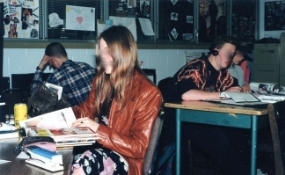
Many consistent patterns appeared when personality preferences combined with significant at-risk behaviors or learning preferences. Other type-related patterns could be seen in students’ input regarding how they would change the traditional school system to aid their learning. These can be summarized as follows:
ISTJ
- Most often were self-referrals to our program, after attending whole school exam prep classes, memory workshops, or study skills groups.
- If they self-referred to our program they usually asked for memory-related strategies.
- The ADD/ADHD students of this type were never referred for ADD related concerns but usually because a parent or staff member noticed that the student was working an exorbitant number of hours.
- Preferred changes: “Make school longer and more strict or leave it the way it is.”
ISTP
- Significantly overrepresented as students who were not performing in school relative to their learning potential.
- Significantly overrepresented in the gifted athlete or artist group.
- Preferred changes: “More practical labs, practice, and visuals.” “Just say what is necessary to get work done—no extras.”
ESTJ
- Preferred changes: “Teachers should be more thorough in their teaching methods.” “More grasp of math and sciences.” “Don’t change much—I like it the way it is.”
ISFJ
- Preferred changes: “Set an outline of exactly what will be covered.” “More discipline—more strict environment.” “Teachers should teach the same material in the same way—always.”
ISFP
- Underestimated their own abilities.
- Were not always willing to join our program as they felt they had heard it all before and took a long time to trust the process.
- ADD did not often manifest as an obstacle to learning.
- Preferred changes: “More freedom of choice—no compulsory classes.” “Have more arts to choose from, visual learning, more colorful.”
ESFP
- One of the most underestimated groups; considered charming and vivacious but not very bright by both parents and teachers.
- Families encouraged hobbies, sports, or other non-academic pursuits but often did not discuss post-secondary goals with them.
- Preferred changes: “Move all my friends so I can concentrate on learning.” “Get rid of attendance records.” “More fun—more visuals/video.”
ESFJ
- Preferred changes: “Make certain teachers care about how people learn.” “Get rid of troublemakers.” “Add more time (even one more year) in high school to break up the work load and reduce student stress.”
INFJ
- Preferred changes: “I wouldn’t expect everyone to be treated the same.” “Smaller classes, more personal attention.” “Less group work.”
INFP
- Intense disconnectedness if a learning issue was present.
- Perfectionists were significantly overrepresented in this group.
- Often immobilized by a learning concern or personal issue.
- Preferred changes: “I hate rows.” “Smaller classes—get rid of the formal atmosphere.” “Kinder teachers—have kids care about each other.” “Work at own pace.”
INTJ
- Preferred changes: “More depth—less repetition—topics not adequately covered.” “All students with similar marks together.” “More scientific study—less English.”
INTP
- ADD/ADHD students needed time to synthesize alternate approaches but for the most part were not significantly effected by the diagnosis.
- ADD students had many natural coping strategies and often self-referred for memory workshops.
- The type most often referred for writing issues, especially a need to expand written material. They felt that one sentence could say it all when an essay was required.
- Often had difficulty acknowledging that any adjustment to their program or approach was needed.
- Preferred changes: “More in depth—less practical drudgery.” “Group by IQ.” “Have strict attitudes.” “Teachers should upgrade skills.” “Desks make me feel like a hostage.” “Teachers are too nosy.”
ESTP
- Most likely to have high test anxiety correlated with failing Kindergarten, Grade 1, or Grade 2. The only type that refused to complete the WISC-R assessment or other formal standardized assessments. Required extensive intervention before formal standardized assessment could be attempted.
- Often had become disillusioned very early; expected to understand something immediately; otherwise, they would give up.
- Although risk-takers in life, they very often would not take risks in their learning.
- Dynamic Assessment (Feuerstein, Reuven, Instrumental Enrichment) worked best with this group.
- Clash of personality type with school type was the main reason for inclusion in an at-risk group.
- Significantly overrepresented in drop-out statistics.
- Preferred changes: “Help me find the easy way to do things.” “Make things exciting.” “Oral tests, more visuals.” “Get rid of attendance recording.”
ENFP
- Most willing of all types to return to the program for a second chance or an adjustment to their program.
- Assessed the latest for severe learning difficulties, but even late intervention allowed successful post-secondary academic careers.
- ADD/ADHD students of this type had extreme difficulty focusing on academic pursuits.
- Among the most fragile in regard to criticism early on in their school history; a negative comment in grade 2 could still be dramatically affecting them in high school.
- Preferred changes: “Allow us to pick our classroom companions and teachers.” “Let our imaginations rule.” “Work at our own pace, personalized courses.” “Groups.”
ENFJ
- Preferred changes: “Brighter students should be allowed to go at their own pace.” “Do more writing.” “Help students be more curious.”
ENTP
- Most likely to make judgments too quickly (“I got it”); often missed all the building blocks, neglecting to note any steps or details to accompany the big picture.
- Clash of personality type with school type was the main reason for inclusion in an at-risk group; learning strategies were quickly assimilated and applied.
- Preferred changes: “Computer technology to replace teachers.” “Make the system more open to student input.” “Open door policy—own pace.” “Student groupings by knowledge.”
ENTJ
- Preferred changes: “Group students by ability not age.” “Replace staff with more technology.” “Emphasize academics.” “Cancel writing.”
ISTP & ESTP
- Athletes overrepresented, trying to balance coaching and high school requirements with community or national level teams.
- Athletes were more willing than their type peers to give the alternate program a second chance, and were more able to face learning difficulties.
- Those without athletic or other extracurricular activities were among those most likely to drop out and not return.
SP Temperament
- Overrepresented in drop-out statistics.
- Underrepresented in willingness to return to school; however, those who did return sometimes even completed requirements early in their graduation year and most were successfully able to graduate with the support of the program (time adjustment was often the only need).
SJ Temperament
- ADD/ADHD students had the best coping strategies of all types; had orderly, creative coping mechanisms to contain attention concerns.
- Most overrepresented of all types to self-refer for learning strategies, memory strategies, and exam preparation workshops.
- Least likely to be referred for assessment for ADD/ADHD.
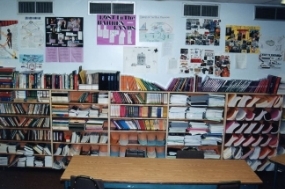
A Classroom Layout for All Types

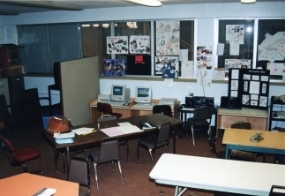
Control Center – Area # 1
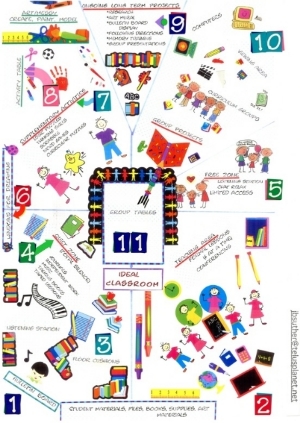
Introverted Space – Areas 2, 3, and 4
These spaces were primarily places where introverted students could be comfortable. Area 2 was a formal teaching area with 6 desks and a blackboard, a favorite with STJ students. Areas 3 and 4 comprised the one place in the room where total silence was required. Students could read, journal, listen to music via headphones, or just recharge in the silence, whether on the floor cushions or in little alcoves. Surprisingly, students of all types took advantage of the area to calm or recharge themselves and it was a particular favorite of the ADHD students, who often retreated to a dark little alcove with a large desk with a green banker’s lamp (corner of area 3). It turned out that the area was even more important for extraverted students because they often became over-stimulated in the more active areas. The one boy who would not leave area 2, 3, or 4 was, I suspect, an INTJ/Asperger’s student. The year before arriving in my classroom he had left his classes several times a day to hide in an empty locker. I got an empty locker ready for him at the beginning of the year but he rarely used it as he could go to area 3 and use headphones or stay in the quiet area.
Extraverted Space – Areas 5, 9, 10, and 11
These were places where more activity and group projects were to take place, the favorite learning environment of extraverted students. Area 5, the Free Zone, had several comfortable chairs and a listening station. Students who wanted to talk could go to this area. The ESFP, ENFP, and INFP students, along with many of the SP students, made very good use of this area as they often could not concentrate on the learning task until they had told their friends the latest news or talked out a problem that was consuming their thoughts. This area prevented more disruptions than anyone would imagine.
Sensory Activity Space – Areas 6, 7, and 8
This is where all the messy stuff happened. Areas 6 and 7 were by the window and you could do fun activities there or you could just look out the window and day-dream. There were logic puzzles, thinking skills activities, word games, scrabble, 3D puzzles, and memory games. Activities could be done alone or in a small group. Area 8 had the largest footprint; it held a long table with art supplies, glue, magazines, Zoodles (fluorescent plastic shapes), juggling balls, and other soft stress balls for squeezing or throwing. SP students particularly loved many of the hands-on activities and many of our extraverted students liked the movement area. This area was essential for our ADD/ADHD students. They could do something active and return to work, ready to cope with the next formal learning task. All students loved this area and would spend every minute of the day there if they could. It was a spectacular motivator for disenchanted students. The NT and NF students could go there if, as often happened, they had finished their work earlier than others. Some students had to be directed to spend time there—for example, students who were slower and seldom finished their work early, or those who were more careful and thorough, as were many of the SJ students.
Conference Grading
I did all the grading in a conferencing session to maximize the amount of time I gave to each student. Most conference sessions took place at the table at Area 11 in the center of the room so that I could keep an eye on everything, but sometimes I used Area 2 because of student preference (SJ) or with students who were unable to concentrate in the middle of the room, e.g., ADD/ADHD or Asperger’s students who needed to be away from everyone. SJ students took the longest to warm up to this method of grading as they only wanted to know whether their work was correct or not—they didn’t want the story. The NTJ students were suspicious of my grading conference method and wondered why I was getting paid if they had to be so involved in the marking process.
Flexibility Within Structure
All students had several ‘works in progress’ that they could work on while I was occupied with grading or instruction. The longer self-directed activities in Area 9 could be research projects (a particular favorite of the NT students) supporting their studies, or special interest pursuits (NT students needed to be encouraged away from this area often), or thinking or study skills activities that supported the other more process-oriented activities. Sometimes students melded art, music, or drama into their study topics. An ESFP student once asked why we couldn’t learn everything this way. The week was tightly organized to provide the security of a familiar routine (for the orderly J students) but each day was entirely flexible within the more formal structure, to offer endless variety and novelty (for the more spontaneous P students). The latter was essential for ADD/ADHD students.
At the end of the day or class we would spend a few minutes on questions, concerns, information sharing, and democratic class meetings to plan the bulletin board. I would suggest what needed to be done, assign students to certain areas for the next day, and students would request or suggest adjustments and changes.
The Analytic Container
How is it that all personality types and all manner of learning-disabled students flourished in a classroom designed by an ISFP? Jungian analyst John Giannini has suggested a possible answer, based on Walter Lowen’s type-related model for the development of consciousness. Lowen’s theory holds that children move through four stages of development, each of which requires a different kind of focus, characterized by one of the four possible pairings of the functions of Jungian typology. The first, and most fundamental of these stages is one of attention to concrete reality within a safe and nurturing environment: the world of Sensing and Feeling (2004, p. 364-385).
Pulitzer-Prize winning author Ronald Kotulak also provides evidence for a kinder, gentler, more maternal model of K-12 schooling:
Stressed students are less able to understand subtle connections, patterns and implications. Under stress the brain uses less of the reflective ‘higher ordered ’thinking skills of the frontal lobes and resorts to using more of the reflexive nature of the amygdala. … Non- stressed learners will exhibit better thinking, understanding, attention, concentration and recall. (1997, p. xi)
If you want to observe students passionate about learning, watch them pursuing their passion. If they draw or paint or play sports or play the violin or successfully interact with people, they do it for hours on end, without fatigue or frustration. This is what we need to see in our schools. So many of our students are in danger of never achieving that sense of wonder, joy, and love of learning. Our educational system’s very existence depends on how engaged our children are in the learning process and what they have learned about themselves as individuals. We have influence on what they will become. We must not squander our gift or theirs by allowing them to pass through our educational institutions without having ignited in them an understanding of themselves as learners, as members of a community, as cooperative members of a group, and as fun-loving, creative seekers of new information. Learning is what the mind does when it is challenged, engaged, captivated, and awe-struck. If only our students—and especially our at-risk students—could experience those feelings in all of their school experiences, rather than just in the occasional class, year, or extracurricular event.
References
Cherkes-Julkowski, M., Sharp, S., & Stolzenberg, J. (1997). Rethinking attention deficit disorders. Northampton, MA: Brookline Books Inc.
Feuerstein, R. (1983). Instrumental enrichment: An intervention program for cognitive modifiability. Baltimore, MD: University Park Press.
Giannini, J. L. (2004). Compass of the soul. Gainesville, FL: CAPT.
Kise, J. A. G. (2007). Differentiation through personality types: A framework for instruction, assessment, and classroom management. Thousand Oaks, CA: Corwin.
Kotulak, R. (1997) Inside the brain: Revolutionary discoveries of how the mind works. Kansas City, MO: Andrews McMeel Publishing.
Sternberg, R. (March, 1997). What does it mean to be smart? Educational Leadership, 54, 6, 20-24.
Van Manen, M. (1994). The tone of teaching. San Diego, CA: Montezuma Publishing.
Webb, J. T. [et.al]. (2005). Misdiagnosis and dual diagnosis of gifted children and adults: ADHD, bipolar, OCD, Asperger’s, depression and other disorders. Scottsdale, AZ: Great Potential Press.
Header Image
Henri Matisse, “Interieur au Phonograph” (1924)


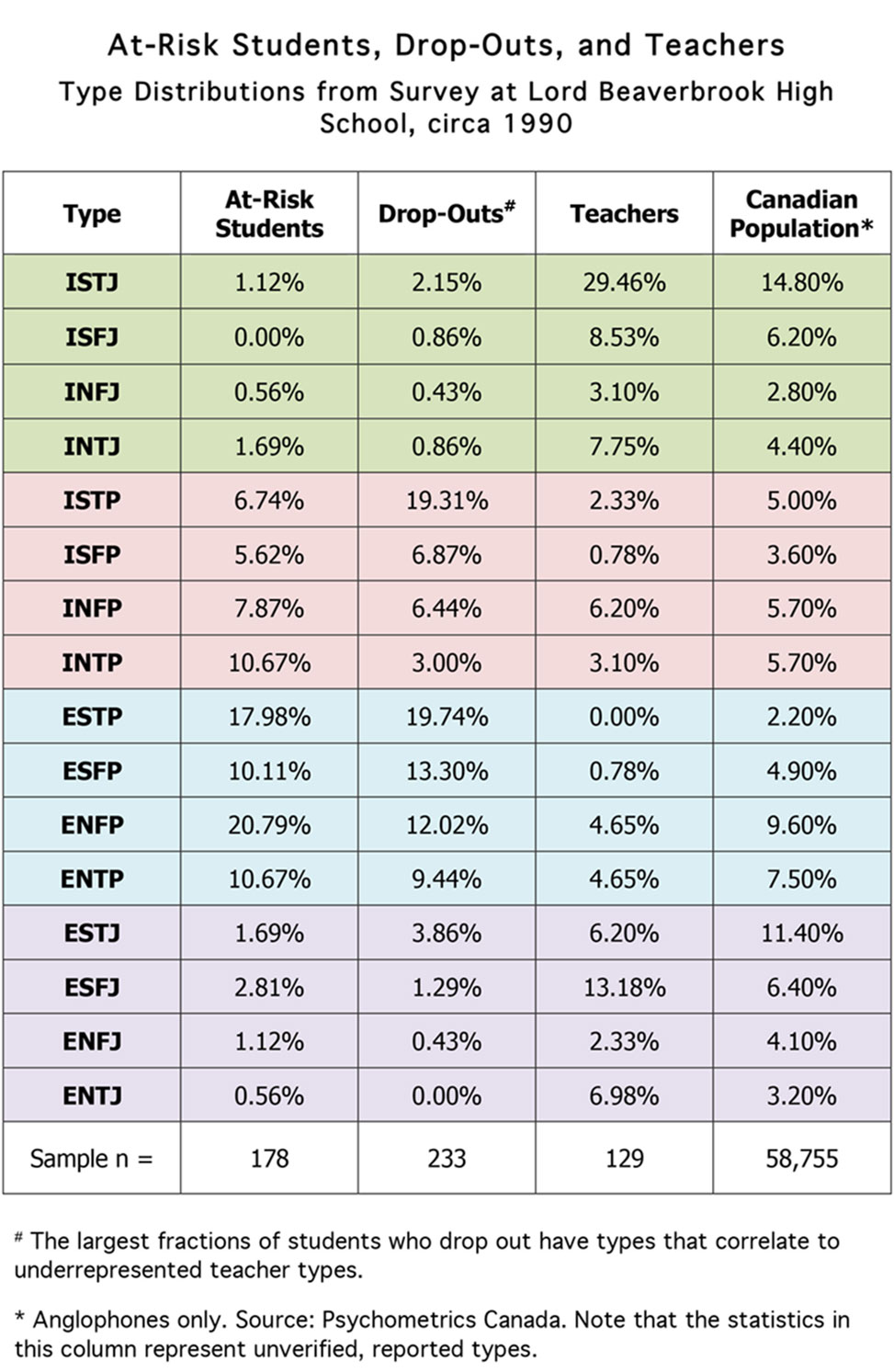
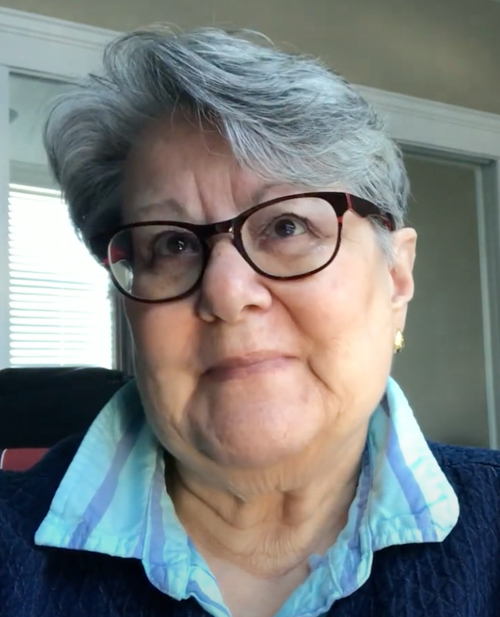









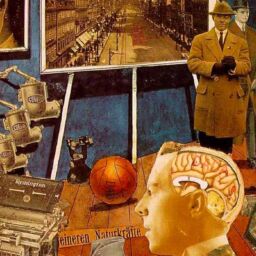



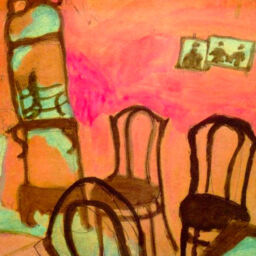

[…] op alle mensen die cognitief of perceptueel om gelijk welke wijze afwijken van de bekrompen norm. A Place for All Types of Learners Sommige type persoonlijkheden zijn zeker verstandig, maar hebben geen plaats in het standaard […]
[…] See on typeindepth.org […]
I think it is very distressing for educators but the intent to address the wave with small changes can be more comfortable for all types while staying true to your own preferences. I have found, over the years,that there are pivotal times when those small changes can take hold or can be destroyed. The INTP physics teacher I mentioned is a good example as I did not finish the story? The changes he made were uncomfortable for him, but the results he saw kept him committed but the department he worked in (15other quite like minded scientific individuals ) met with him and voted as a department that he should adhere to department policy and go back to his previous way of examining. There was the pivotal moment when he could have said ” No” but he said he would follow the department’s wishes. He was very distressed but instead of saying no he agonized and then spent the next few years feeling guilty. If he could have encouraged his department to try those few small changes they would have been open to more dramatic changes later.
I should add that Garry Ryan worked with me in two of the schools I worked in. As a creative writing instructor and writer himself so he was a natural and he insisted on melding all his creative writing students with our at risk or drop outs who were invited back to our program. ( a story for another time you would have been hard pressed to pick out the top writers and some of our so called non writers in some of his projects) As an NP with so many very detail oriented students he was definitely out of his personal preference zone but he took so many of those young people from being unable or unwilling to risk writing a sentence to unbelievable results ( some novels were produced)One student an ESTJ came to me one day and said she did not want to work with Garry. I was astounded because every student wanted to work with him. When I asked her why she said “He will not critique my writing.He is always positive.” I sent her back and asked her to tell Garry what she needed and how she needed to be approach.Very out of his comfort zone,he complied and she stayed and successfully made her university entrance requirements.
MaryAnne has written a book as well. Her philosophy is based on relevant and sound research. This approach works. One of the biggest obstacles its path is not the students (they are its biggest supporters). It is established systems and practices which are antiquated and based on mistaken premises.
We wanted to publish this article because it suggests one way to address the teacher’s dilemma of how to accommodate 16 types: Simply rearrange the classroom. But there’s another, even more interesting message deep in the article, and that is the connection with John Giannini’s work suggesting that ALL types begin life in a Sensing-Feeling environment and need that to develop. This concept accords with what biologist James Zull said in his book, The Art of Changing the Brain, where, without knowing anything about type, he gives multiple examples of how important it is to engage the Sensing function in learning. For those interested in having a variety of classroom strategies that reach multiple types, have a look at Zull’s book. (The subtitle is: Enriching the Art of Teaching by Exploring the Biology of Learning.)
It should be noted that there were many, many success stories in MaryAnne’s classroom. In a nutshell the classroom structure was designed to meet the needs of the students rather than the needs of the teacher or the system. Far from being theoretical, her classroom was designed to be very practical in meeting specific learning requirements. This design created an environment that was energizing for students and teachers.
As a college teacher myself, I note that it is NOT equally easy for all types of TEACHERS to adjust to the technology-driven changes that are sweeping across the educational landscape. Just as students can’t reasonably be expected to swim upstream against the current of their type in order to succeed in school, teachers can’t reasonably be expected to swim against the current of THEIR type to succeed in their profession. I worry that the tidal wave of change is washing out some people who were formerly world-class teachers but who can’t find a discipline-appropriate and type-appropriate way to accommodate the changes. At age 58, I don’t have to worry too much about this (will retire before the paradigm shift is complete), but my younger colleagues do.
What, I wonder, can be done to help teachers prepare for these changes? I have toyed with using the “flipped classroom” approach, but it is far from a natural fit to my discipline.
Mark, I’m with you here. Education shd see major changes in the next years. Teachers at all levels as facilitators and explainers and connectors. Teaching is awakening the student to knowledge.
Debra could probably give us some good advice based on her experiences.
I still want to change the educational system however,I did learn to cheer with great enthusiasm anyone who would take just ONE strategy or idea and implement something they could easily control. One Physics teacher I worked with (INTP) had me come to speak to all his top students (all bound for physics related careers or research facilities) about their individual learning preferences and strategies they could try for writing examinations and other test wise strategies. Although the session was for his students he implemented only two ideas from a 3 hour session that allowed his students to make significant gains on exams (he was hooked and one of my most enthusiastic supporter)He much more willing to look at adjustment for individuals,and he could see that just a small adjustment could make a huge difference
Mark what an excellent observation. I would suggest that in high school and even with younger children we could look at the facilitator role much more often than we do.
Marlowe raised the question, ‘How could the principles from Mary Anne’s classroom be applied to higher ed?’ A radio feature that I heard a few hours later seemed to contain some possible clues to an answer. The interviewees made the point that the World Wide Web has made virtually any information easily accessible to anyone with a computer. Many higher-ed teachers and other world-class experts have made (or soon will) their lectures available through on-line sources; and one can ‘google’ any subject almost indefinitely. They go on to point out that not only can students access unlimited information in this way, but when motivated to learn about something, they already do gather more information (accurate or not) about the subject on line than they do or could from a single lecturer and accompanying course materials. And web marketers know that they are selecting their information more based on how it’s packaged than on content. So this self-designed research path is already being shaped by individuals’ learning-style preferences—including those with a basis in typology.
I’ve never been a professional teacher (in the conventional, institutional sense), but it seems to me that this all means that higher-ed teachers no longer need to see their principal role as being the primary information source. If they could reimagine their role as something more akin to a guide—a mentor, facilitator, co-designer, filterer (of questionable sources), arbiter, cheerleader, etc.—and integrate the resources now available (including their own knowledge), it seems like this would be a big step (perhaps the crucial step) toward enabling students to co-create optimal learning experiences for themselves. Granted, egos built around being the expert in the room, may have a hard time with such a transition; but if the people on the radio are right, they no longer are anyway.
Love hearing about all your applied ideas, Mary, thanks. My sister used temperament and the E/I scale to shape her classroom instruction a bit, so you’re not alone.
David Keirsey, the author of “Please Understand Me,” said that ADHD was over diagnosed. Mostly, they were kids with the SP temperament. Your statistics pretty much agree with what he said. I’m happy to hear of the success of your classroom. I think it should be replicated in every school.
Fascinating article, Mary Anne. I found similar results for at-risk and drop-out by type in my study of first-semester college students. Thank you for sharing your results.
Very thought-provoking article, thanks. It would be fascinating to speculate about how a variant of these ideas and techniques could be used at the postsecondary level. Since college professors tend to be IN-J types (modal type), those with dramatically contrasting types (ES-P) tend to be substantially at risk in that environment (speaking anecdotally). Thoughts about how to apply concepts from the article to higher education would be welcomed. Thanks again. (A challenge is that academic rigor is usually defined as mastery of theories, which privileges Introverts with iNtuition.)